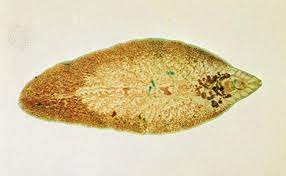Trematodes (Flukes)
Small, flat, leaf-like worms, flattened dorso-ventrally with @@no body cavity@@
Body mass consists of: @@mesodermal parenchyma@@, where internal organs are embedded
@@Oral and ventral suckers@@ that help attach to the host
Infest various organs of the human host
- e.g. intestinal veins, urinary bladder, liver, lung
Use @@freshwater snails@@ as an @@intermediate host@@

Classification
Domain: Eukaryote
Kingdom: Animalia
Phylum: Platyhelminthes (flatworms)
Class: Trematodes (flukes)
Hermaphroditic Flukes
Hermaphrodite: organism that has both kinds of reproductive organs and can produce both gametes associated with male and female sexes
Life cycle beginning: hermaphroditic adult fluke produces %%eggs in the human%% (definitive host)
- eggs are %%excreted%% into the environment
- first larval stage (miracidium) develops inside the eggs
- the larvae seek out and infect suitable %%snail species%% (first intermediate host)
- %%asexual reproduction%% occurs in the snail
- several intermediate development forms can be distinguished (sporocyst, redia) and the final larval stage (cercaria)
- leave the snail and seek out %%second intermediate host%%
- a fish or crustacean
- in the second intermediate host, the cercaria form cysts called metacercaria excysts
- if the infected %%raw or under-cooked fish%% or crustacean is eaten by a human, the metacercaria excysts, and the fluke %%invades tissues%% (such as the lung or liver) and begins %%producing eggs%%
Sexual Flukes (Schistosomes)
- called “blood flukes”
- have separate distinct sexes
- similar life cycle to hermaphroditic flukes
- ==only one intermediate host (snail)==
- acquired by: schistosome cercaria %%directly penetrating%% the skin in %%contaminated rivers and lakes%%
- adult schistosomes take up residence in various abdominal veins
- in fresh water, the organisms infect snails (in which they multiply)
- cercaria are released into the fresh water
Trematodes Include
- Hepatic/liver flukes
- Fasciola hepatica
- Intestinal flukes
- Fasciolopsis buski
- Heterophyes heterophyes
- Lung flukes
- Paragonimus westermani
- Blood flukes
- Schistosoma haematobium
- Schistosoma mansoni